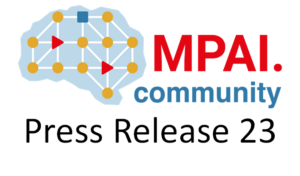Geneva, Switzerland – 18 May 2022. Today the international, non-profit, unaffiliated Moving Picture, Audio and Data Coding by Artificial Intelligence (MPAI) standards developing organisation has concluded its 20th General Assembly. Among the outcomes is the communication that a patent pool will soon be established for four of its standards: AI Framework (MPAI-AIF), Context-Based Audio Enhancement (MPAI-CAE), Compression and Understanding of Industrial Data (MPAI-CUI) and Multimodal Conversation (MPAI-MMC).
The four standards have been developed based on the MPAI process;
- Between December 2020 and March 2021. MPAI issues 4 Calls for Technologies each referring to two documents – Functional Requirements and Framework Licence.
- In the September to December 2021 time frame, the 4 standards have been approved.
- In December 2021 and January 2022, the MPAI Secretariat requested its members to declare whether they believed holding patents essential to the four standards.
- In March 2022, the Secretariat issued a Call for Patent Pool Administrators on behalf of the identified patent holders.
- In May 2022, the result of the Call was communicated to patent holders.
According to the MPAI process, the patent holders will select the patent pool administrator with a majority of 2/3 of the patent holders’ votes. The licences shall have a total cost comparable with the total cost of similar technologies and be released not after products are on the market.
MPAI is developing the Calls for Technologies with associated Functional Requirements and Framework Licences for Version 2 of the MPAI-AIF and MPAI-MMC standards, planning to publish the Calls on 19 July 2022. The definition of the terms of the Framework Licences, a licence without critical data such as cost, dates, rates etc., is a prerogative of the MPAI Principal Members.
Version 2 will substantially extend the capabilities of Version 1 of the 3 standards by supporting three new use cases:
- Conversation About a Scene: a human holds a conversation with a machine about objects in a scene of which the human is part. While conversing, the human points their fingers to indicate their interest in a particular object.
- Human-Connected Autonomous Vehicle Interaction: a group of humans converse with a Connected Autonomous Vehicle (CAV) on a domain-specific subject (travel by car). The machine understands the utterances, the emotion in the speech and the expression in the faces and in the gestures of the humans it is conversing with, and manifests itself as head and shoulder of an avatar whose face and head convey emotions congruent with the uttered speech.
- Avatar Videoconference. Avatars participate in a videoconference reproducing the upper part of the human bodies they represent with a high degree of accuracy. A virtual secretary with a humanly appearance creates an online summary of the meeting. The quality of the summary is enhanced by the virtual secretary’s ability to detect the avatars’ emotions and expressions and to interact with avatars requesting changes to the summary. The quality of the interaction os enhanced by the virtual secretary’s ability to show emotions and expressions.
MPAI develops data coding standards for applications that have AI as the core enabling technology. Any legal entity supporting the MPAI mission may join MPAI, if able to contribute to the development of standards for the efficient use of data.
So far, MPAI has developed 5 standards (normal font in the list below), is currently engaged in extending two approved standards (underlined) and is developing other 9 standards (italic).
| Name of standard | Acronym | Brief description |
| AI Framework | MPAI-AIF | Specifies an infrastructure enabling the execution of implementations and access to the MPAI Store. MPAI-AIF V2 is being prepared. |
| Context-based Audio Enhancement | MPAI-CAE | Improves the user experience of audio-related applications in a variety of contexts. MPAI-CAE V2 is being prepared. |
| Compression and Understanding of Industrial Data | MPAI-CUI | Predicts the company performance from governance, financial, and risk data. |
| Governance of the MPAI Ecosystem | MPAI-GME | Establishes the rules governing the submission of and access to interoperable implementations. |
| Multimodal Conversation | MPAI-MMC | Enables human-machine conversation emulating human-human conversation. MPAI-MMC V2 is being prepared. |
| Server-based Predictive Multiplayer Gaming | MPAI-SPG | Trains a network to compensate data losses and detects false data in online multiplayer gaming. |
| AI-Enhanced Video Coding | MPAI-EVC | Improves existing video coding with AI tools for short-to-medium term applications. |
| End-to-End Video Coding | MPAI-EEV | Explores the promising area of AI-based “end-to-end” video coding for longer-term applications. |
| Connected Autonomous Vehicles | MPAI-CAV | Specifies components for Environment Sensing, Autonomous Motion, and Motion Actuation. |
| Avatar Representation and Animation | MPAI-ARA | Specifies descriptors of avatars impersonating real humans. |
| Neural Network Watermarking | MPAI-NNW | Measures the impact of adding ownership and licensing information in models and inferences. |
| Integrative Genomic/Sensor Analysis | MPAI-GSA | Compresses high-throughput experiments data combining genomic/proteomic and other. |
| Mixed-reality Collaborative Spaces | MPAI-MCS | Supports collaboration of humans represented by avatars in virtual-reality spaces called Ambients |
| Visual Object and Scene Description | MPAI-OSD | Describes objects and their attributes in a scene and the semantic description of the objects. |
Visit the MPAI website, contact the MPAI secretariat for specific information, subscribe to the MPAI Newsletter and follow MPAI on social media: LinkedIn, Twitter, Facebook, Instagram, and YouTube.
Most importantly: join MPAI, share the fun, build the future.


